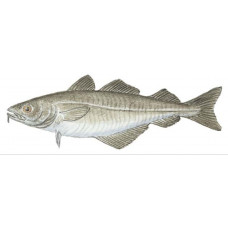Latin name
Pollachius virens
Other names
Coalfish, Boston bluefish, green cod, blisterback, saithe, coley.
Identification
It has an olive-green or greenish-brown color on top and yellowish-gray on the sides and belly, with a silvery hue. The caudal fin is notched. The second dorsal fin is long and the pelvic fins are short. It can be distinguished from other members of the family by three features: the lower jaw protrudes beyond the upper jaw, the tail is forked, and the lateral line is fairly straight, not bent over the pectoral fins. The young have cod-like barbs on their chin, but they are small and usually disappear with age. The European pollock differs from the pollock in its lateral line, which is curved above the pectoral fins.
Distribution
Occurs in the waters of the North Atlantic Ocean, from the Bay of Biscay in the south to Spitsbergen in the north and Novaya Zemlya in the northeast. In North America - from the Chesapeake Bay in the south to the Davis Strait in the north. Occurs off the west and east coasts of Greenland. Keeps in large numbers around Iceland, in the North Sea, off the southwestern and northern coasts of Norway, in the western part of the Barents Sea.
Habitat
Keeps in the water column and near the bottom. As a rule, it is a deep or medium-water fish, preferring rocky bottoms in shallow waters. They live at depths of up to 100 fathoms, although they can also be found at depths of up to 4 fathoms.
Size
Can grow up to 31⁄2 feet, although most adults are much smaller. The average fish weighs between 4 and 15 pounds. The record weight is 50 pounds. Slowly growing fish, they reach a size of about 30 inches at age 9. They are reported to live until 31 years of age, but few live longer than 12 years. Becomes sexually mature at 3 years of age, but matures in weight at 5-7 years at 55-70 cm in length.
Life history and Behavior
The spawning period is in late fall and early winter. Their eggs float and drift freely at the surface, and for the first 3 months the larvae are at or near the surface. The young move in large, densely packed flocks near the surface.
Food and feeding habits
It feeds on large aggregations of small herring, small cod and their relatives, as well as sand eels and various tiny crustaceans. About 45 species of different animals have been recorded in the stomachs of commercial-sized fish (36-125 cm).
Reproduction
Spawning occurs in almost all habitats except the Barents Sea: off the southern shores of Iceland, the Faroe, Orkney, and Shetland Islands, in the northern North Sea, along the coast of Norway - north to the Lofoten Islands. Off the coast of North America, spawning areas from Cape Cod to New England. Off the coast of Norway, spawning from January to April, mass spawning observed in February and March. Salmon spawns relatively close to shore at a depth of 100-200 m on soft substrates at a water temperature of 5-10 °C (mainly 6-7 °C) and a salinity of 35.14-35.26%. Fecundity of ranges from 225,000 to 6.5 million eggs in large individuals, is on average 4 million eggs. The eggs are pelagic, with an average diameter of 1.15 mm. Larvae 3.0-3.8 mm long hatch at a water temperature of 6-7 °C on about the 12th day. Fry at 22-35 mm in length (age about three months) from open sea areas enter the coastal zone.
| Classification | |
| Phylum | Chordata |
| Class | Actinopterygii |
| Squad | Gadiformes |
| Family | Gadidae |
| Genus | Pollachius |
| Species | P. virens |
| Features | |
| Conservation status | Least Concern |
| Habitat | Pelagic |
| Life span, years | 25 |
| Maximum body weight, kg | 32 |
| Maximum length, cm | 130 |
| Sailing speed, m/s | No information |
| Threat to people | Edible |
| Way of eating | Predator |
Pollock
Tags: Pollock




